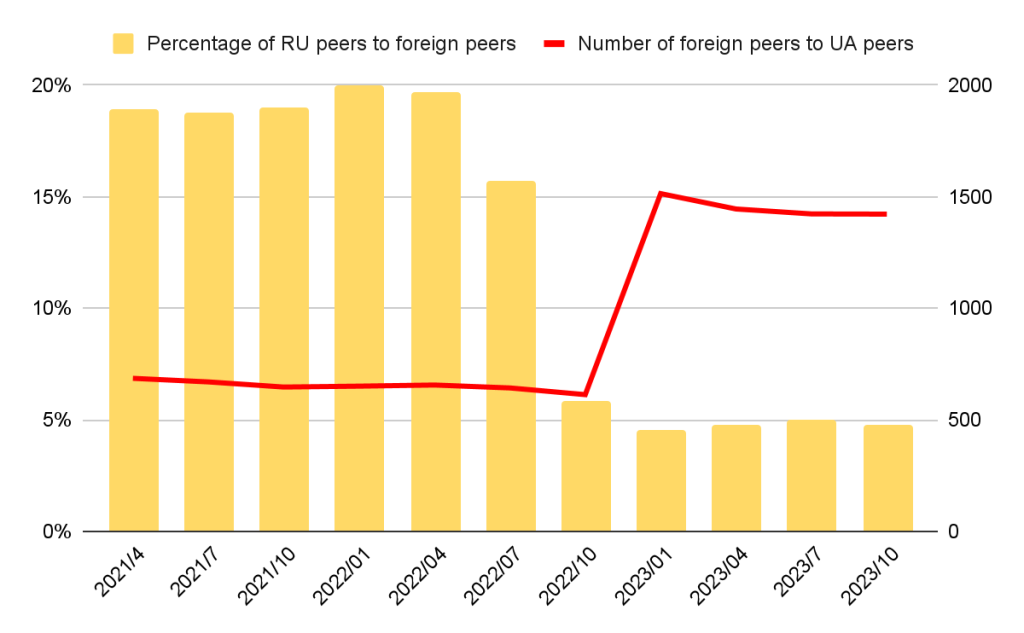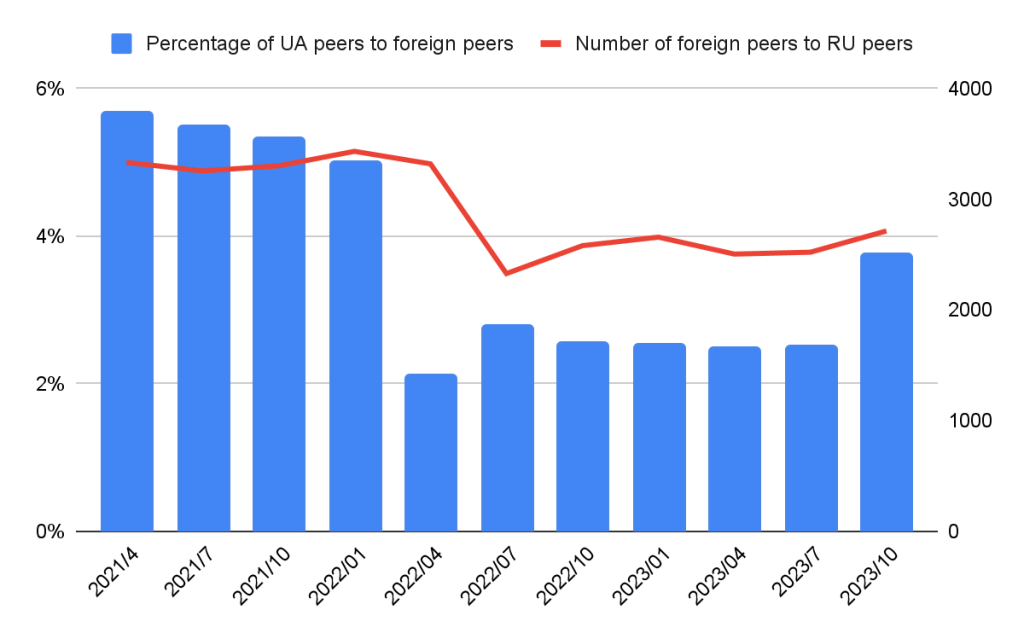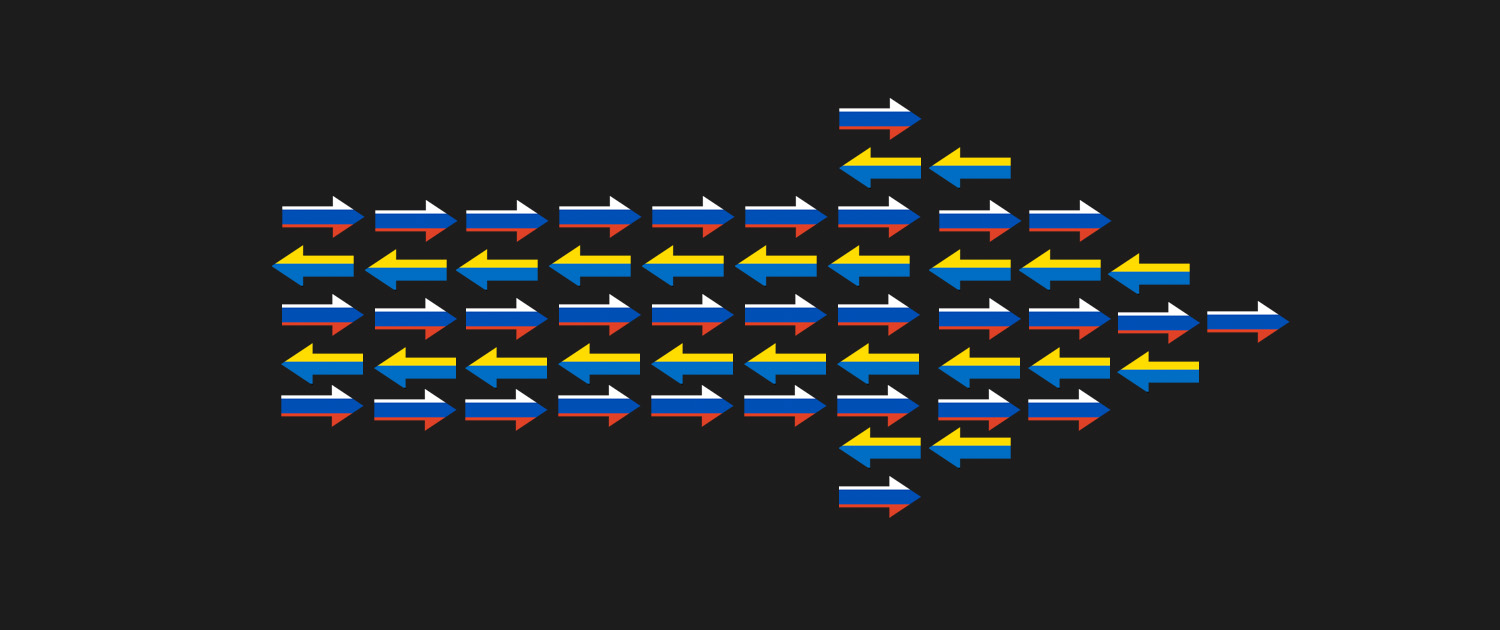Following Russia’s full-scale invasion of Ukraine, which started on 24 February 2022, private and government institutions have introduced or significantly expanded economic sanctions against Russia.
According to a study by my colleagues and me, these sanctions have significantly impacted peering connectivity and Internet infrastructure in not only Russia but also Ukraine. However, we also show that significant change was at foot before the invasion.
De-peering Activity on IXPs and Facilities
From April 2021 to October 2023, our study shows de-peering activity by Ukrainian, Russian, and international networks at Internet exchange points (IXPs) and colocation facilities in both countries began months before the invasion.
Figure 1 shows the rate of non-Ukrainian networks connecting (peering) or disconnecting (de-peering) with Ukraine IXPs, specifically from Russia and the United States (US). We observed a significant increase in de-peering activity compared to the average rate between July 2021 and October 2021 (6.3 times higher than usual) and between October 2021 and January 2022 (8.4 times higher than usual). The majority of networks de-peering were Russian.

Figure 2 shows how a similar number of networks from outside Russia connected and disconnected with these Russian IXPs at the same time.
Although we can see a significant increase in de-peering activity even before the July-October 2021 period mentioned in Figure 1, the de-peering rate from April 2021 to July 2021 was approximately 7.4 times higher than the average.
The most dramatic shift occurred right before the invasion. In this timeframe, Russian IXPs and facilities disconnected from almost all Ukrainian IXPs, resulting in a staggering 18.3 times higher de-peering rate than the average.

De-peering Based on AS Peer-to-Peer Relationships
Next, we explore how the war between Russia and Ukraine impacted both countries’ peer-to-peer (P2P) connectivity according to CAIDA’s AS Relationship dataset.
We observed a significant rise in foreign peers connecting to Ukrainian peers from October 2022 (Figure 3). This number nearly doubles by January 2023, jumping from 680 to 1,500, and stays elevated after that.
This growth suggests a potential effort by Ukraine to bolster its Internet infrastructure by establishing new P2P connections with international partners.
In the same period, the percentage of Russian peers compared to total foreign peers drastically dropped from 18% to just 5%. This reflects the severed ties and isolation between Ukrainian and Russian Internet infrastructures.

When looking at Russia’s P2P landscape (Figure 4), we observed a steady decline in the number of foreign peers connecting to Russian peers, dropping from 3,333 initially to 2,329 by July 2022. This decrease aligns with international sanctions imposed on Russia, potentially causing foreign companies to sever P2P connections or relocate services.
Additionally, the percentage of Ukrainian peers compared to total foreign peers shows a significant decline, dropping from 5.61% to 2.11% in April 2022 and remaining below 2.5% for most of the timeline. This reinforces the diminished P2P relationship between Russia and Ukraine. Interestingly, there was a slight increase to 3.4% in October 2023, but the overall trend reflects the isolation of Russian P2P networks.

Changing Geopolitical Landscape
The invasion also impacted the registry country codes of operational networks in Ukraine and Russia. This likely reflects the changing geopolitical landscape and potential regional Internet governance shifts.
While recent data suggests a tentative stabilization in all indicators, the conflict has caused permanent disruptions with the closure of Ukrainian IXPs.
While Ukraine actively seeks to rebuild and strengthen its P2P infrastructure through international connections, Russia faces isolation due to sanctions and severed ties with Ukraine.
These findings highlight the war’s lasting impact on Internet infrastructure and the importance of international cooperation for rebuilding efforts and
the need for further research on long-term consequences and potential solutions to ensure a more resilient and interconnected global Internet.
Read our TMA 2024 paper to learn more about this work.
Antonis Chatzivasileiou is a PhD student at the University of Crete, focusing on Internet resilience. His research involves developing a comprehensive taxonomy to understand and enhance the Internet’s ability to withstand disruptions.
The views expressed by the authors of this blog are their own and do not necessarily reflect the views of the Internet Society.


